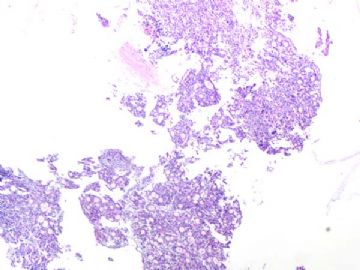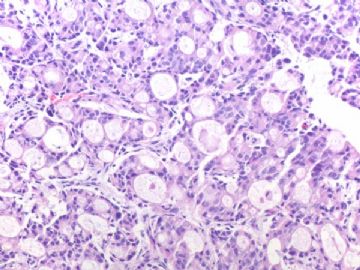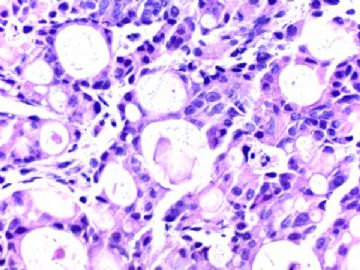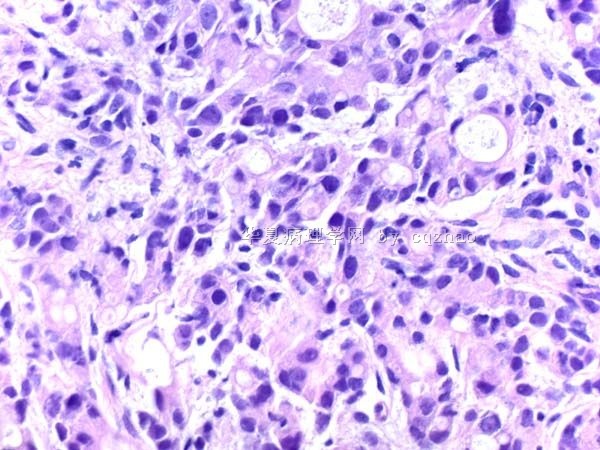| 图片: | |
|---|---|
| 名称: | |
| 描述: | |
- B291244 y/f vaginal bleeding, endometrial biopsy
(女,44岁,阴道不规则出血,子宫内膜活检)
40x
200x
400x
-
本帖最后由 于 2010-10-02 09:19:00 编辑
相关帖子
 谢谢Dr.cqzhao!
谢谢Dr.cqzhao!
内膜标本呈明显的腺样结构,分化不算太差,但是没有内膜腺体或间质起源的迹象。既然有乳腺癌病史,我重点考虑乳腺癌转移。
鉴别诊断:
继发性腺癌(乳腺癌首选)?
原发的少见腺癌(怎么看也不像啊,没有一种内膜癌亚型能对得上号)
免疫组化(mammaglobin,GCDFP-15、CK、Vimentin)和/或复习乳腺癌切片有助于诊断。
我只见过一例乳腺癌转移到内膜和卵巢,为浸润性多形性小叶癌。

华夏病理/粉蓝医疗
为基层医院病理科提供全面解决方案,
努力让人人享有便捷准确可靠的病理诊断服务。
-
本帖最后由 于 2010-10-03 07:33:00 编辑
非常好的病例,36岁(2003)时患有乳腺癌,44岁子宫内膜刮出组织中见腺癌。
病理诊断应该从二个方面考虑:
1)原发性内膜样腺癌,特殊类型(Endometrioid adenoncarcinoma with a microglandular pattern)
首先,年轻乳腺癌患者很可能有遗传史,如BREA-1、BRCA-2基因突变;HNCPP、Lynch综合症等易患因素。其次乳腺癌病人抗雌激素治疗也是发生内膜癌的危险因素之一。
2)乳腺癌转移
鉴别诊断的简单方法是复习2003年乳腺癌病理切片,根据形态考虑诊断和IHC标记,WT-1可用于鉴别乳腺和内膜癌。
谢谢!

- xljin8
| 以下是引用xljin8在2010-10-3 7:31:00的发言:
非常好的病例,36岁(2003)时患有乳腺癌,44岁子宫内膜刮出组织中见腺癌。 病理诊断应该从二个方面考虑: 1)原发性内膜样腺癌,特殊类型(Endometrioid adenoncarcinoma with a microglandular pattern) 首先,年轻乳腺癌患者很可能有遗传史,如BREA-1、BRCA-2基因突变;HNCPP、Lynch综合症等易患因素。其次乳腺癌病人抗雌激素治疗也是发生内膜癌的危险因素之一。 2)乳腺癌转移 鉴别诊断的简单方法是复习2003年乳腺癌病理切片,根据形态考虑诊断和IHC标记,WT-1可用于鉴别乳腺和内膜癌。 谢谢! |
赞赏金主任的精辟分析。乳腺癌转移至子宫不能除外。
如果是子宫原发性微小腺体型腺癌,可能主要见于宫颈管内膜发生或宫颈。
本例的形态学不同于一般的宫内膜腺癌,形态学更倾向乳腺浸润性导管癌转移至子宫。

- 王军臣
|
乳腺癌转移到女性生殖道很少见。有文献报道主要是转移到子宫内膜和卵巢,转移到子宫颈罕见。 本例报道的是乳腺浸润性导管癌同期转移到子宫颈。 Arch Gynecol Obstet. 2010 Apr;281(4):769-73. Epub 2009 Oct 30. Breast cancer with synchronous massive metastasis in the uterine cervix: a case report and review of the literature.Bogliolo S, Morotti M, Valenzano Menada M, Fulcheri E, Musizzano Y, Casabona F. Department of Gynecology, Breast Unit, University of Genoa, 10 Largo Rosanna Benzi, Genoa, Italy. stefanobogliolo@libero.it AbstractINTRODUCTION: Metastatic breast cancer is rare in the female genital tract, and when present it more commonly tends to involve ovary or endometrium; uterine cervix is only occasionally involved. This condition poses differential diagnostic problems in the settings of clinical and pathological investigations. CASE PRESENTATION: An asymptomatic 78-year-old woman came to our attention in the context of routine gynecological surveillance; clinical examination disclosed enlarged uterine body and cervix. Our patient then underwent computed tomography and magnetic resonance imaging that outlined the possibility of cervical cancer with parametrial involvement. Moreover, a suspect mass was found on the mammogram in the left breast. Breast surgical excision was performed, which revealed invasive breast carcinoma, while synchronous cervical biopsy discovered distant metastasis in the uterine cervix. On histological examination, both lesions showed non-cohesive architectural pattern consistent with lobular morphology; anyway, to rule out primary poorly differentiated cervical cancer, appropriate immunohistochemical panel was performed, which confirmed the mammary derivation of the tumor. Due to disseminate disease, the patient underwent multisystemic medical treatment including radiotherapy, chemotherapy and hormone therapy, and she is still alive at 30-month follow-up. DISCUSSION: Genital tract metastases in patients with known breast carcinoma can present with abnormal vaginal bleeding, but they often are asymptomatic. Therefore, only strict gynecological surveillance of these patients can permit early detection of these secondary lesions. Aggressive treatment of isolated cervical metastasis should be performed when feasible; otherwise, systemic chemotherapy with taxane could be sufficient in increasing survival. It should be emphasized that, in most cases, only accurate immunohistochemical investigation, particularly if performed on the primary lesion as well, can solve differential diagnostic problems and allow the clinician to establish appropriate treatment. |

- 王军臣
本例报道进展期乳腺癌出现阴道流血,病理证明为乳腺癌转移至子宫内膜。转移癌的形态结构有些像蜕膜样的结构特点,像是内膜本身间质发生的病变,但细胞异型、核分裂以及表达乳清蛋白等标志物可鉴定为转移性乳腺癌。
Arch Gynecol Obstet. 2009 Feb;279(2):199-201. Epub 2008 May 10.
Abnormal uterine bleeding as a presentation of metastatic breast disease in a patient with advanced breast cancer.
Karvouni E, Papakonstantinou K, Dimopoulou C, Kairi-Vassilatou E, Hasiakos D, Gennatas CG, Kondi-Paphiti A.
Department of Pathology, Aretaieion Hospital, University of Athens, Athens, Greece.
Abstract
BACKGROUND: Extragenital carcinomas secondarily involving the uterus are very rare and they usually occur as a manifestation of widespread disease. When the metastases involve the endometrium in a diffuse, permeative pattern, sparing the glands, they may cause problems in the diagnosis.
CASE: A case of metastatic carcinoma to the endometrium with a decidua-like pattern is reported. The patient had a history of breast carcinoma and presented with vaginal bleeding. The pathologic findings in the uterine curettings raised the differential diagnosis between metastatic breast carcinoma and non-neoplastic stromal lesions. The presence of nuclear atypia and mitotic activity along with the appropriate immunohistochemical findings revealed the neoplastic nature of the endometrial lesion and confirmed its origin from the breast.
CONCLUSION: Unusual uterine bleeding in a patient with breast cancer should alert the gynecologist to the possibility of metastatic breast disease. Furthermore, the metastasis to the uterus and to other organs of the genital tract can be considered as a preterminal event.

- 王军臣
本例报道化生性乳腺癌在盆腹腔广泛转移,其中弥漫浸润子宫内膜。
Gynecol Oncol. 2000 Apr;77(1):216-8.
Uterine metastasis from a heterologous metaplastic breast carcinoma simulating a primary uterine malignancy.
Sinkre P, Milchgrub S, Miller DS, Albores-Saavedra J, Hameed A.
Department of Pathology, University of Texas Southwestern Medical Center, Dallas, Texas 75235, USA.
Abstract
OBJECTIVE: To describe the first distant metastasis of a heterologous metaplastic breast carcinoma in the uterus and discuss its differential diagnosis.
METHODS: Light microscopy, immunohistochemistry, and flow cytometry were used to evaluate the tumor.
RESULTS: A 58-year-old woman underwent mastectomy for metaplastic breast carcinoma confined to the breast. She presented 4 years later with vaginal bleeding. The endometrial curettage showed a poorly differentiated carcinoma. She underwent hysterectomy and bilateral salpingo-oophorectomy as well as pelvic and periaortic lymphadenectomy. Clinical and intraoperative findings favored a primary uterine malignancy. The uterus was markedly distorted with multiple gray-white, solid subserosal, and intramural tumor nodules. The tumor diffusely infiltrated the endometrium sparing benign endometrial glands. The tumor nodules were distributed full thickness of the myometrium. These nodules were composed of high-grade malignant epithelial cells with areas of chondroid metaplasia. Extrauterine microscopic tumor was present in left ovary, pelvic, and periaortic lymph nodes. The histologic features and estrogen/progesterone receptors (ER/PR) as well as DNA ploidy analysis of the uterine tumor showed striking similarity with those of the primary metaplastic breast carcinoma. A diagnosis of metastatic metaplastic breast carcinoma in the uterus was rendered.
CONCLUSION: A metastatic heterologous metaplastic breast carcinoma with cartilaginous metaplasia should be considered in the differential diagnosis of heterologous uterine malignant mixed mesodermal tumor (MMMT) and high-grade endometrioid carcinoma with rare foci of cartilage.

- 王军臣
本例报道浸润性小叶癌转移至宫颈。
J Obstet Gynaecol Res. 2007 Aug;33(4):578-80.
Metastasis of lobular breast carcinoma to the cervix.
Perisić D, Jancić S, Kalinović D, Cekerevac M.
Department of Obstetrics and Gynecology, Gornji Milanovac Medical Center, Serbia. perisic@eunet.yu
Abstract
Breast cancers without previous dissemination occasionally result in hematogenous metastases in gynecologic organs, particularly in the cervix. This case report examines a multimodally treated lobular breast cancer patient who was 52 months later diagnosed with malignancy in the uterus. After a tumor was detected at the endocervical and isthmic part of the uterus, a complete hysterectomy with bilateral salpingo-oophorectomy was carried out. The malignant cells were highly positive for carcino-embrional antigen and gross cystic disease fluid protein-15, sensitive breast cancer markers. In conclusion, as breast carcinoma can metastasize to atypical places (cervix, endometrium, etc.), regular surveillance of patients should include gynecologic control

- 王军臣
本例报道浸润性乳腺癌转移至子宫平滑肌瘤中。
J Gynecol Obstet Biol Reprod (Paris). 1993;22(3):243-4.
[Metastasis of breast cancer to a uterine leiomyoma]
[Article in French]
Afriat R, Lenain H, Vuagnat C, Michenet P, Luthier F, Maitre F, Grossetti D.
Service de Gynécologie-Obstétrique, Hôpital Notre-Dame-de-Bon-Secours, Paris.
Abstract
The authors report a case of metastasis of cancer from the breast in a uterine leiomyoma. The metastases into the body of the uterus from extragenital cancers are rare. If they occur they are usually in the myometrium where they are asymptomatic and where the diagnosis is difficult, or in the endometrium where the diagnosis can be made by biopsy after curettage. A few rare cases of metastases in uterine leiomyoma have been reported in the literature. They can be the cause of very sudden increase in size of fibroids with compression of the pelvic organs.

- 王军臣
-
本帖最后由 于 2010-10-03 14:14:00 编辑
下列文献为WT1与乳腺癌的相关文献,供网友们参考。
Pathology. 2010;42(6):534-9.
Armes JE, Bowlay G, Lourie R, Venter DJ, Price G.
Department of Pathology, Mater Health Services, South Brisbane, Queensland, Australia. jane.armes@mater.org.au
Abstract
AIMS: There is a high frequency of serous gynaecological and basal breast cancers in patients with germline BRCA1 mutations. These patients often undergo prophylactic salpingo-oophorectomies, where small tumours may be identified in which morphological distinction between primary serous and metastatic basal breast cancer may be problematic. These two cancer types share similar molecular genetics and have immunophenotypic overlap. We aimed to develop an immunohistochemical panel which could differentiate between these two tumour types.
METHODS: Immunohistochemistry was performed on a training set of 20 serous gynaecological and 20 basal breast cancers, from which a small differential panel was developed. This differential panel was tested in an additional validation set of serous and basal cancers.
RESULTS: WT1, ER and CK5/6 expression successfully differentiated serous gynaecological and basal breast cancers. WT1 and ER expression was significantly more common in serous cancers and CK5/6 expression more common in basal cancers.
CONCLUSION: There is considerable genetic, morphological and immunophenotypic overlap between serous gynaecological and basal breast cancers. A limited panel of WT1, ER and CK5/6 was found to optimally differentiate these tumour types. Differences in the expression of these proteins appear to reflect the expression pattern of their cell of origin, rather than identify aberrant oncogenic pathways.
2.
Indian J Cancer. 2009 Oct-Dec;46(4):303-10.
Gupta S, Joshi K, Wig JD, Arora SK.
Department of Immunopathology, Postgraduate Institute of Medical Education & Research, Chandigarh, India.
Abstract
BACKGROUND: The product of Wilms' tumor suppressor gene (WT1), a nuclear transcription factor, regulates the expression of the insulin-like growth factor (IGF) and transforming growth factor (TGF) systems, both of which are implicated in breast tumorigenesis and are known to facilitate angiogenesis. In the present study, WT1 allelic integrity was examined by Loss of Heterozygosity (LOH) studies in infiltrating breast carcinoma (n=60), ductal carcinoma in situ (DCIS) (n=10) and benign breast disease (n=5) patients, to determine its possible association with tumor progression.
METHODS: LOH at the WT1 locus (11p13) as determined by PCR-RFLP for Hinf1 restriction site and was subsequently examined for its association with intratumoral expression of various growth factors i.e. TGF-beta1, IGF-II, IGF-1R and angiogenesis (VEGF and Intratumoral micro-vessel density) in breast carcinoma.
RESULTS: Six of 22 (27.2%) genetically heterozygous of infiltrating breast carcinoma and 1 of 4 DCIS cases showed loss of one allele at WT1 locus. Histologically, the tumors with LOH at WT1 were Intraductal carcinoma (IDC) and were of grade II and III. There was no correlation in the appearance of LOH at WT1 locus with age, tumor stage, menopausal status, chemotherapy status and lymph node metastasis. The expression of factor IGF-II and its receptor, IGF-1R was significantly higher in carcinoma having LOH at WT1 locus. A positive correlation was observed between the TGF-beta1, VEGF expression and IMD scores in infiltrating carcinoma.
CONCLUSIONS: The current study indicates that the high frequency of loss of allelic integrity at Wilms' tumor suppressor gene-1 locus in high-graded breast tumors is associated with aggressiveness of the tumor.
3.
Cancer Biomark. 2009;5(3):109-16.
Center of Anatomy and Functional Morphology, Mount Sinai School of Medicine, New York, NY, USA.
Abstract
Our previous studies revealed that Wilms' tumor 1 (WT-1) protein was highly expressed in breast myoepithelial (ME) and endothelial cells. As the human breast tissue is rich in ME cells and blood vessels, our current study intended to assess whether WT-1 immunohistochemistry may have dual usages in evaluation of the ME cells and micro-vessel density. Consecutive sections were prepared from breast tumors with co-existing normal, hyperplastic, and neoplastic components. Consecutive sections were immunostained for WT-1 and a panel of ME and endothelial cell markers. From each case, 4-5 randomly selected duct clusters were photographed, and the percentages of positive cells for these molecules were compared. Similar to ME cell marker CD10 and smooth muscle actin (SMA), WT-1 expression was preferentially seen in ME cells, and over 90% of WT-1 positive ME cells were immunoreactive to CD10 and SMA. Distinct WT-1 expression was also seen in endothelial cells, and over 90% of WT-1 positive endothelial cells were positive for blood vessel specific markers. With tumor progression, the percentage and intensity of WT-1 positivity decreased in ME cells, whereas increased in endothelial cells. These finding suggest that WT-1 immunohistochemistry may be used to assess both the ME cells and micro-vessel density.
4.
Int J Biol Sci. 2009;5(1):82-96. Epub 2009 Jan 9.
Xu Z, Wang W, Deng CX, Man YG.
Department of Thyroid and Breast Surgery, China-Japan Union Hospital, Jilin University, Changchun, Jilin, China.
Abstract
Our recent studies revealed that focal alterations in breast myoepithelial cell layers significantly impact the biological presentation of associated epithelial cells. As pregnancy-associated breast cancer (PABC) has a significantly more aggressive clinical course and mortality rate than other forms of breast malignancies, our current study compared tumor suppressor expression in myoepithelial cells of PABC and non-PABC, to determine whether myoepithelial cells of PABC may have aberrant expression of tumor suppressors. Tissue sections from 20 cases of PABC and 20 cases of stage, grade, and age matched non-PABC were subjected to immunohistochemistry, and the expression of tumor suppressor maspin, p63, and Wilms' tumor 1 (WT-1) in calponin positive myoepithelial cells were statistically compared. The expression profiles of maspin, p63, and WT-1 in myoepithelial cells of all ducts encountered were similar between PABC and non-PABC. PABC, however, displayed several unique alterations in terminal duct and lobular units (TDLU), acini, and associated tumor tissues that were not seen in those of non-PABC, which included the absence of p63 and WT-1 expression in a vast majority of the myoepithelial cells, cytoplasmic localization of p63 in the entire epithelial cell population of some lobules, and substantially increasing WT-1 expression in vascular structures of the invasive cancer component. All or nearly all epithelial cells with aberrant p63 and WT-1 expression lacked the expression of estrogen receptor and progesterone receptor, whereas they had a substantially higher proliferation index than their counterparts with p63 and WT-1 expression. Hyperplastic cells with cytoplasmic p63 expression often adjacent to, and share a similar immunohistochemical and cytological profile with, invasive cancer cells. To our best knowledge, our main finings have not been previously reported. Our findings suggest that the functional status of myoepithelial cells may be significantly associated with tumor aggressiveness and invasiveness.
5.
Anticancer Res. 2008 Jul-Aug;28(4B):2155-60.
Department of Surgery, Creighton University Medical School, Omaha, NE 68178, USA.
Abstract
BACKGROUND: The Wilms' tumor suppressor gene, wt1, encodes a zinc-finger protein, WT1, that functions as a transcription regulator. Previous studies have suggested a contradictory role for WT1 in breast cancer development.
MATERIALS AND METHODS: MCF10AT3B cells, a cell line derived from a xenograft model of progressive human proliferative breast disease, were used to study WT1 function in early development of breast cancer. A stable cell line was established from MCF10AT3B cells that ectopically expressed the Wilms' tumor suppressor, WT1. Western blot analysis, in vitro and in vivo growth assays were used to study the effects of constitutive WT1 expression on malignant progression of MCF10AT3B cells.
RESULTS: WT1 expression had a profound effect on several aspects of the cell cycle machinery and inhibited estrogen-stimulated and nonstimulated cell growth in vitro. In nude mice, WT1 expression strongly suppressed estrogen-stimulated tumorigenesis of neoplastigenic MCF10AT3B cells.
CONCLUSION: WT1 plays an important role in maintaining normal growth of mammary epithelial cells and dysregulated WT1 expression may contribute to breast cancer development.
6.
Mod Pathol. 2008 Oct;21(10):1217-23. Epub 2008 May 9.
WT1 immunoreactivity in breast carcinoma: selective expression in pure and mixed mucinous subtypes.
Domfeh AB, Carley AL, Striebel JM, Karabakhtsian RG, Florea AV, McManus K, Beriwal S, Bhargava R.
Department of Pathology, Magee-Womens Hospital, University of Pittsburgh Medical Center, Pittsburgh, PA 15213, USA.
Abstract
Current literature suggests that strong WT1 expression in a carcinoma of unknown origin virtually excludes a breast primary. Our previous pilot study on WT1 expression in breast carcinomas has shown WT1 expression in approximately 10% of carcinomas that show mixed micropapillary and mucinous morphology (Mod Pathol 2007;20(Suppl 2):38A). To definitively assess as to what subtype of breast carcinoma might express WT1 protein, we examined 153 cases of invasive breast carcinomas. These consisted of 63 consecutive carcinomas (contained 1 mucinous tumor), 20 cases with micropapillary morphology (12 pure and 8 mixed), 6 micropapillary 'mimics' (ductal no special type carcinomas with retraction artifacts), 33 pure mucinous carcinomas and 31 mixed mucinous carcinomas (mucinous mixed with other morphologic types). Overall, WT1 expression was identified in 33 carcinomas, that is, 22 of 34 (65%) pure mucinous carcinomas and in 11 of 33 (33%) mixed mucinous carcinomas. The non-mucinous component in these 11 mixed mucinous carcinomas was either a ductal no special type carcinoma (8 cases) or a micropapillary component (3 cases). WT1 expression level was similar in both the mucinous and the non-mucinous components. The degree of WT1 expression was generally weak to moderate (>90% cases) and rarely strong (<10% cases). None of the breast carcinoma subtype unassociated with mucinous component showed WT1 expression.
7.
Hum Pathol. 2008 May;39(5):666-71. Epub 2008 Mar 12.
Moritani S, Ichihara S, Hasegawa M, Endo T, Oiwa M, Yoshikawa K, Sato Y, Aoyama H, Hayashi T, Kushima R.
Department of Pathology and Clinical Laboratories, Nagoya Medical Center, Nagoya, Aichi 460-0001, Japan. moritani@nnh.hosp.go.jp
Abstract
Serous papillary adenocarcinoma of the female genital organs and invasive micropapillary carcinoma of the breast have close histologic similarities. Thus, when these cancers occur synchronously or metachronously in the same patient, it is difficult to determine the primary site. We examined 23 serous papillary adenocarcinomas (16 ovarian, 5 endometrial, and 2 peritoneal) and 37 invasive micropapillary carcinomas of the breast (12 pure and 25 mixed types) on immunohistochemical expression of Wilm's tumor antigen-1 (WT1), CA125, and gross cystic disease fluid protein-15 (GCDFP-15), which have been reported to be useful in the differential diagnosis of primary ovarian carcinomas versus metastatic breast cancer to the ovary. The positive rates of WT1, CA125, and GCDFP-15 in serous papillary adenocarcinomas were 78%, 78%, and 0%, respectively, and the corresponding rates in invasive micropapillary carcinomas were 3%, 40%, and 38%. The CA125-positive rate of invasive micropapillary carcinoma was higher than the rate reported for other types of breast carcinomas. We consider CA125 to be not always useful in the differential diagnosis of serous papillary adenocarcinoma and invasive micropapillary carcinoma. Although the positive rate of WT1 was significantly higher in serous papillary adenocarcinoma than in invasive micropapillary carcinoma, WT1 expression in endometrial serous papillary adenocarcinoma was infrequent (20%). WT1 and GCDFP-15 could be useful markers for the differential diagnosis of ovarian and peritoneal serous papillary adenocarcinoma versus breast invasive micropapillary adenocarcinoma. However, the availability of GCDFP-15 is limited because of the low positive rate of GCDFP-15 in invasive micropapillary carcinomas.

- 王军臣
-
nfykdx2008 离线
- 帖子:734
- 粉蓝豆:28
- 经验:761
- 注册时间:2010-09-08
- 加关注 | 发消息
Mod Pathol. 2008 Oct;21(10):1217-23. Epub 2008 May 9.
WT1 immunoreactivity in breast carcinoma: selective expression in pure and mixed mucinous subtypes.
Domfeh AB, Carley AL, Striebel JM, Karabakhtsian RG, Florea AV, McManus K, Beriwal S, Bhargava R.
Department of Pathology, Magee-Womens Hospital, University of Pittsburgh Medical Center, Pittsburgh, PA 15213, USA.
Abstract
Current literature suggests that strong WT1 expression in a carcinoma of unknown origin virtually excludes a breast primary. Our previous pilot study on WT1 expression in breast carcinomas has shown WT1 expression in approximately 10% of carcinomas that show mixed micropapillary and mucinous morphology (Mod Pathol 2007;20(Suppl 2):38A). To definitively assess as to what subtype of breast carcinoma might express WT1 protein, we examined 153 cases of invasive breast carcinomas. These consisted of 63 consecutive carcinomas (contained 1 mucinous tumor), 20 cases with micropapillary morphology (12 pure and 8 mixed), 6 micropapillary 'mimics' (ductal no special type carcinomas with retraction artifacts), 33 pure mucinous carcinomas and 31 mixed mucinous carcinomas (mucinous mixed with other morphologic types). Overall, WT1 expression was identified in 33 carcinomas, that is, 22 of 34 (65%) pure mucinous carcinomas and in 11 of 33 (33%) mixed mucinous carcinomas. The non-mucinous component in these 11 mixed mucinous carcinomas was either a ductal no special type carcinoma (8 cases) or a micropapillary component (3 cases). WT1 expression level was similar in both the mucinous and the non-mucinous components. The degree of WT1 expression was generally weak to moderate (>90% cases) and rarely strong (<10% cases). None of the breast carcinoma subtype unassociated with mucinous component showed WT1 expression.






















